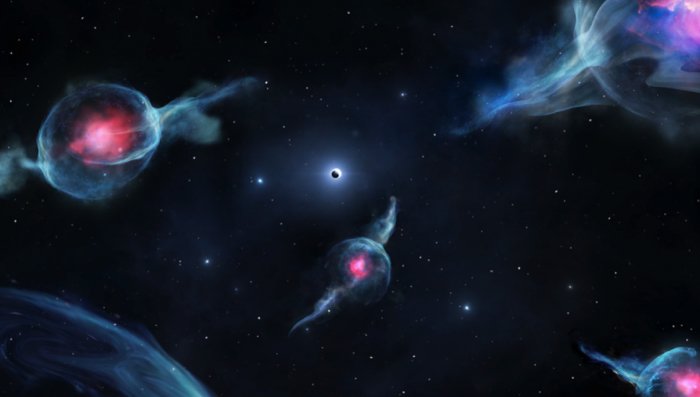科学家们说,极罕见的生命成分可能起源于外太空
科学家们说,极罕见的生命成分可能起源于外太空
Phosphorus, an element that's key in forming DNA and fuelling life on Earth, may have first arrived on the planet via comets from newborn stars.
磷是形成DNA和促进地球生命的关键元素,可能是通过新生恒星的彗星首次抵达地球的。
Since the element is extremely rare in the Universe, its presence on Earth has been a long-standing mystery. But scientists at the European Southern Observatory (ESO) now suggest that phosphorus may have first arrived on Earth in the molecule phosphorus monoxide – phosphorus bonded with one oxygen molecule.
由于这种元素在宇宙中极为罕见,它在地球上的存在一直是个谜。但欧洲南方天文台(ESO)的科学家们现在认为,磷最早可能是通过一氧化二磷分子(磷与一个氧分子结合)到达地球的。
Their research, published in the journal Monthly Notices of the Royal Astronomical Society on Wednesday, reveals that phosphorus monoxide forms amid the birth of new stars.
他们的研究发表在周三的《皇家天文学会月刊》(Monthly notice of the Royal Astronomical Society)上。

They also found the molecule in a comet circling Jupiter: a frozen ball of rock and ice called 67P/Churyumov-Gerasimenko, or "67P" for short.
他们还在一颗环绕木星的彗星上发现了这种分子:一个由岩石和冰组成的冰冻球体,名为67P/Churyumov-Gerasimenko,简称“67P”。
The discovery suggests comets could have carried phosphorus monoxide to Earth.
这一发现表明彗星可能携带了一氧化磷到地球。
Phosphorus is essential for life as we know it, Kathrin Altwegg, an author of the new study, said in a press release.
“正如我们所知,磷是生命所必需的。”这项新研究的作者之一凯瑟琳·阿尔特韦格(Kathrin Altwegg)在一份新闻稿中说。
As comets most probably delivered large amounts of organic compounds to the Earth, the phosphorus monoxide found in comet 67P may strengthen the link between comets and life on Earth.
“由于彗星很可能向地球输送了大量的有机化合物,在67P彗星中发现的一氧化磷可能会加强彗星与地球生命之间的联系。”
Phosphorus is rare in the Universe but essential to life (in most cases). It acts as glue that holds together the chains of nucleotides that make up DNA. Phosphorus also helps build cell walls and store cells' energy.
磷在宇宙中很少见,但对生命却是必不可少的(在大多数情况下)。它像胶水一样把组成DNA的核苷酸链粘在一起。磷还有助于建造细胞壁和储存细胞的能量。
To figure out how the element arrived on Earth, astronomers turned to the stars.
为了弄清这种元素是如何抵达地球的,天文学家们转而研究恒星。
Using the Atacama Large Millimetre/Submillimeter Array (ALMA) in Chile, the scientists behind the new study looked at a star-forming region called AFGL 5142.
利用智利的阿塔卡马大型毫米/亚毫米阵列(ALMA),这项新研究背后的科学家观察了一个名为AFGL 5142的恒星形成区域。
Studying the wavelengths of light coming from that distant region allowed them to determine which kinds of molecules interact with that light.
通过研究来自那个遥远区域的光的波长,他们可以确定哪种分子与光相互作用。
They found phosphorus-carrying molecules forming around the new stars.
他们发现携带磷的分子在新恒星周围形成。
Stars are born when clouds of gas and dust collapse, giving into gravity and coalescing into new cosmic objects. When massive stars are still young, they send out flows of gas that open huge cavities in the clouds of interstellar dust around them.
恒星是在气体云和尘埃坍缩时产生的,在重力作用下合并成新的宇宙物体。当大质量恒星还很年轻时,它们会释放出气体流,在它们周围的星际尘埃云中打开巨大的空洞。
Scientists think molecules with phosphorus begin to form on the walls of these cavities as they're pummelled with radiation from the young, massive stars.
科学家认为,在年轻的大质量恒星的辐射冲击下,含磷分子开始在这些空洞的壁上形成。
But even after pinpointing a potential origin for phosphorus-carrying molecules in the Universe, a big question remained: How did those molecules travel to Earth?
但是,即使确定了宇宙中携带磷的分子的潜在起源,一个大问题仍然存在:这些分子是如何到达地球的?
The researchers turned to data from a spacecraft called Rosetta, which orbited the 67P comet from August 2014 to September 2016.
研究人员转向了一艘名为“罗塞塔”(Rosetta)的航天器的数据,该航天器在2014年8月至2016年9月期间环绕这颗67P彗星运行。
Astronomers had already found traces of phosphorus in data Rosetta gathered about 67P, but they hadn't determined which molecule the element was part of.
天文学家已经在罗塞塔收集的67P数据中发现了磷的踪迹,但他们还没有确定这种元素属于哪个分子。
Then, Altwegg said, an astronomer at a conference made a suggestion: "She said that phosphorus monoxide would be a very likely candidate, so I went back to our data, and there it was".
然后,Altwegg说,一位天文学家在一次会议上提出了一个建议:“她说一氧化二磷是一个非常可能的候选者,所以我看我们的数据,发现它就在那里。”
Phosphorus monoxide can end up in comets after the walls of a newborn star's surrounding cavity collapse. The molecule can get trapped in frozen grains of dust that circle the new star, some of which eventually coalesce into comets.
在一颗新生恒星周围的空腔坍塌后,一氧化磷会在彗星中消失。这些分子会被困在环绕这颗新恒星的冻结尘埃中,其中一些最终会合并成彗星。
Astronomers think that comets may have delivered other chemical components of life, such as amino acids and even water, to early Earth as well.
天文学家认为,彗星可能也向早期地球提供了其他生命的化学成分,如氨基酸甚至水。
Phosphorus seems to be yet another life-giving element that the space snowballs brought when they pummelled the planet.
磷似乎是太空雪球撞击地球时带来的另一种生命元素。
- 频道推荐
- |
- 全站推荐
- 推荐下载
- 网站推荐


















